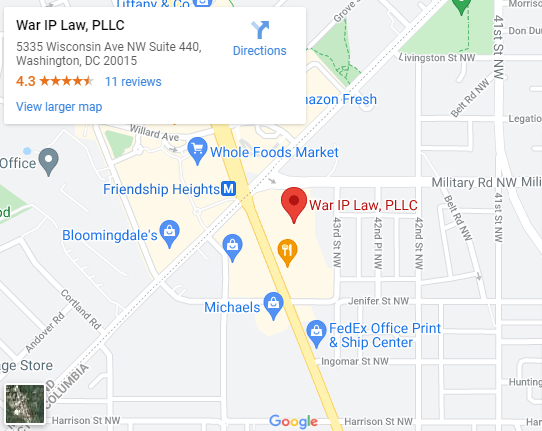Per the United States Patent and Trademark Office (USPTO), it is the responsibility of registered trademark owners and applicants to regularly check their registration or application status. Doing this is vital since it ensures current and prospective trademark registrants are aware of any additional documentation they need to forward to the USPTO to maintain or gain registration; it also means they can avoid missing any crucial upcoming deadlines. Learn about monitoring an existing trademark status and find out how a Washington, D.C. intellectual property lawyer may be able to aid prospective or current trademark owners by calling War IP Law PLLC at (202) 952-4004.
What Is a Trademark Status?
The status of a trademark indicates its progress in terms of gaining or maintaining trademark registration. Applicants and registrants monitor a mark’s status by using the USPTO’s Trademark Status & Document Retrieval (TSDR) tool, a searchable database enabling users to see, print, and download details that are relevant to their trademark’s registration and application status. Furthermore, the TSDR service helps individuals, companies, and attorneys keep track of crucial registration and filing deadlines, preventing the potential abandonment of an application or registration.
How Do I Track My Trademark Status?
Trademark applicants or registrants obtain a receipt containing a registration, reference, or serial number, which they can use to navigate the TSDR database. To track the status of their trademark registration, they need only to enter this number into the system. Here, they can view and download documents uploaded by the USPTO or the applicant, as well as conducting the following searches:
- The current owner of a particular mark
- Basic or trademark-specific information
- Prosecution history
- The products and services associated with the trademark
- Attorney correspondence
How Do I Know if My Trademark Is Active?
Trademark owners can benefit from understanding the meaning of a mark’s status since it makes it clear to these parties whether their trademark is active and what they need to do to gain or maintain the protections offered by trademark registration. Below is a brief explanation of the common trademark statuses.
Under Examination
Under examination means the USPTO has assigned a trademark examiner, or examining attorney, to review the application. This provides assurance that the application has been received and is being or will be reviewed soon.
Issuing of Office Actions
An examining attorney who identifies a possible problem with a mark, such as similarity to an already registered trademark or the failure to meet all the requirements for registering a mark, issues an office action. Applicants must respond to these promptly; otherwise, the USPTO considers the application abandoned.
Published
If the applicant fulfills the requests outlined in the office action, or if no office action is necessary, the USPTO publishes the mark. The publication period lasts for 30 days, during which time interested parties can contest the trademark’s registration.
Notice of Allowance
The USPTO issues this notice when a trademark receives no opposition during the publication period. Essentially, at this point the mark is close to registration, provided the applicant files their Statement of Use within six months or seeks an extension. Find out more information regarding the surveillance of a current trademark status and discover how a Washington, D.C. intellectual property lawyer may be able to assist individuals and businesses with their trademark concerns by organizing a consultation with War IP Law PLLC.
Abandoned
Abandoned trademarks refer to ones in which the trademark applicant or owner failed to respond to an office action. For applicants, if they did not submit their Statement of Use on time, the USPTO may assign their trademark this status. This status may also be assigned if the applicant does not respond to an office action within the allotted time, the trademark was registered but not used or used improperly, or the trademark expired because the required maintenance documents were not filed.
Registered
This indicates that a mark has achieved official registration. No further action or information is necessary until the USPTO requires renewal documentation.
How Do You Check if a Phrase Is Already Trademarked?
According to the International Trade Administration (ITA), free searches for registered and applied-for marks, including trademarked phrases, are possible via the USPTO’s Trademark Electronic Search System (TESS). That said, this will not show unregistered trademarked phrases already used by the trademark owner. Aim to uncover similar marks when conducting these searches, and consider the following points while browsing TESS:
- Search for synonyms of trademarked phrases.
- Check for similar-sounding phrases with alternative word endings and spellings.
- Think about the products and services related to the phrase; the USPTO may allow identical phrases if they concern completely different goods and services, but identical or similar phrases linked to the same or related products and services are unlikely to achieve registration.
Can You Trademark Something That Already Exists?
Generally, if someone has used a mark, then another party cannot register it for themselves. If an individual decides to register a particular trademark and an alternative party can prove they used it first, they could contest and successfully oppose the mark’s registration.
What Is Trademark Watch?
Trademark watch refers to a service offered by private companies that enables individuals and companies to easily monitor trademark databases. These providers obtain government data related to trademark applications and then notify customers if they find a filing similar to a customer’s existing mark. Existing trademark registrants can then use this information to complete the following tasks:
- Seek the refusal of the application
- Contact the applicant to reach a resolution
- Attempt to extend the period of opposition to allow more time for negotiation with the applicant
- Formally oppose the application
Contact a Washington, D.C. Intellectual Property Lawyer Today
Registering a trademark can be a long and complex process; however, responsibly monitoring the status of an application or current registration can help trademark owners and applicants stay on top of their paperwork and deadlines. Utilizing the USPTO’s TSDR service can assist businesses and individuals with effectively checking the status of their trademarks while also staying abreast of whether another party is seeking to register a similar mark. Understand more about checking your current trademark status and explore the legal options available to trademark owners by reaching out to a seasoned Washington, D.C. intellectual property lawyer from War IP Law PLLC at (202) 952-4004.






